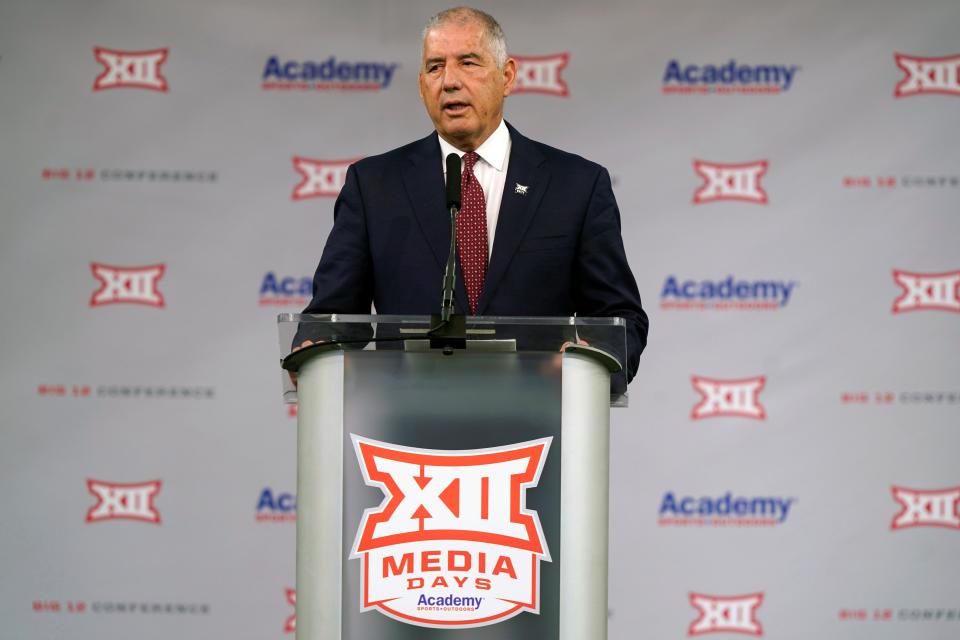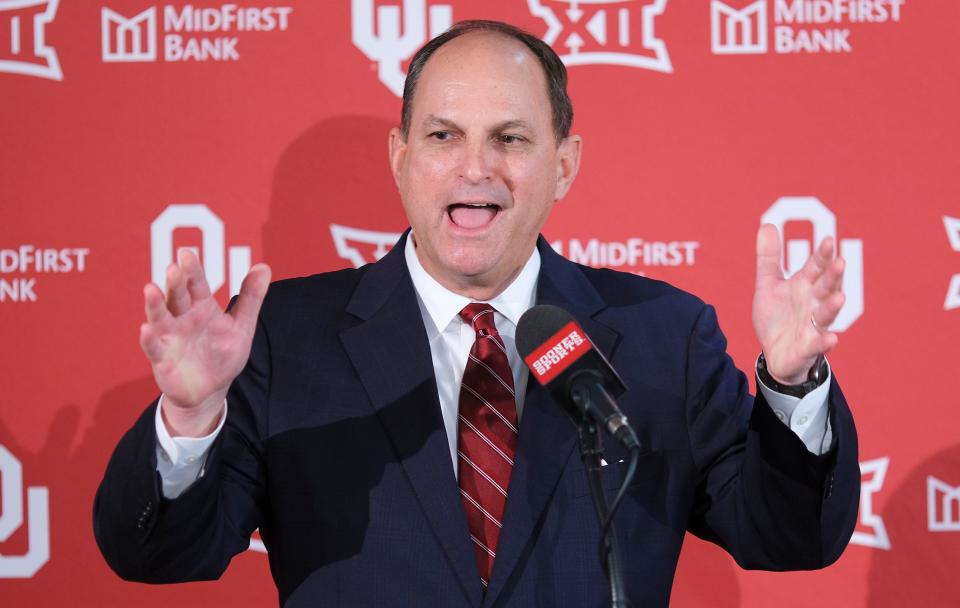Big 12 commissioner Bob Bowlsby says there's 'some weirdness' at spring meetings
- Oops!Something went wrong.Please try again later.
IRVING, Texas — There are representatives from the Big 12's four future members attending the conference's spring meetings, along with the lingering presence of Texas and Oklahoma, the league's only football national champions who still are three years away from their scheduled departures to the SEC.
Outcoming commissioner Bob Bowlsby, who announced his retirement earlier this year with plans to stay on until his replacement is found, figures he is down to 30-90 days left on the job.
“This meeting has got some weirdness to it,” Bowlsby said. “It would be less than forthright to not admit that there’s some strangeness to it, and perhaps even some periods when there’s a little bit of tension. But, you know, people are working together in good faith. And we get along and work together because we have to."
A time of membership transition in the Big 12 comes when it, like schools and leagues across the country, are dealing with transfer rules and how student-athletes are getting compensated for use of their names, images and likenesses, and just who is involved with that process.
Tramel's ScissorTales: BYU glad to help with Big 12 Conference's football TV contract

“I don’t know that the change in membership is causing us any particular scrambling," Bowlsby said. “The members going out, the continuing members, we all share the same challenges. ... It’s not like they’re coming in to a uniquely different environment with a different set of challenges.”
BYU will officially join the Big 12 next summer. The growing anticipation is that current American Athletic Conference schools Cincinnati, Houston and UCF will as well, instead of having to wait until July 1, 2024.
The Big 12, a 10-team league since 2011 and that way for another year, could have 14 schools for two years after that. Texas and Oklahoma will move to the SEC no later than July 1, 2025.
“I think the tenor’s good. I mean, honestly, you move on from some of the decisions. We know the two schools, Oklahoma and Texas, are leaving. But at the same time, they’re league members for the next two years,” West Virginia athletic director Shane Lyons said. “And with the four new schools coming in ... they start having a voice in the process. You’re looking at the league as a whole to say what’s best for the league.”
Athletic directors had their joint meeting Thursday with the Big 12 board comprised of the president or chancellor from each member school. The board's executive session Friday, which is expected to include an update on the search for a new commissioner, will wrap up the meetings.
Texas AD Chris Del Conte said there is “nothing that's contentious.” He described the meetings business as usual while including discussions about the reshaping of the league.
“It’s a little different, but we’re all participating and making decisions that are going to best serve the institutions, for us for a shorter period of time than the others," Oklahoma AD Joe Castiglione said.
Tramel: Nick Saban-Jimbo Fisher feud fueled by college football coaches losing control

Bowlsby said the agenda for the annual meetings that began Wednesday maybe should have been color-coded. There were some items for the current 10 members, some for all 14 schools, others for the future schools that are observing and interacting without a vote on issues, and even some for only the eight remaining schools — Baylor, Iowa State, Kansas, Kansas State, Oklahoma State, Texas Tech, TCU and West Virginia.
There will be no final decisions this week on future schedules — for football or other sports — and if the league would return to divisions.
The Big 12 became a 10-team league and scrapped divisions in 2011, during a two-year transition when Colorado, Missouri, Nebraska and Texas A&M left the league while TCU and West Virginia came in. Changes in NCAA legislation allowed the Big 12 in 2017 to resume its football championship game, pitting the top two teams in the standings after a round-robin league schedule.
“We’re still considering whether divisions are the right thing for us, or whether one group together is the right thing,” said Bowlsby, adding that could differ among sports.
As for NIL, which went into effect last summer with few guidelines, Lyons said there have been a lot of positives and negatives.
“So where do we end up somewhere in between, where our student-athletes can capitalize of name, image and likeness, but we’re not using them for pay-for-play, and we’re not using it for inducements,” Lyons said. “That’s the bad part right now ... some institutions are using it as recruiting inducements and making promises on the front end. And that was really never anticipated. It was a matter of once a student-athlete becomes a student-athlete, how he or she can capitalize off their name, image and likeness.”
Tramel's ScissorTales: Will SEC keep 8-game conference schedule when OU football arrives?
SEC weighs expanding conference schedule
SEC coaches and athletic directors have been meeting this week at a resort on the Gulf Coast of Florida. Atop the agenda is whether the conference schedule should expand from eight to nine games when the league itself grows from 14 to 16 teams with the additions of Texas and Oklahoma.
Whether a decision comes by the time the spring meetings wrap up Friday is still to be determined — and seeming more unlikely at the end of Wednesday's sessions.
"We've got some questions still to answer," Commissioner Greg Sankey said. “We’ve got more work to do.”
The SEC presidents, who have final say on schedule change, meet Thursday with the ADs. Sankey said the executive committee would be updated on the discussions and the conference was in no rush to make a decision, but would not commit to whether the group would vote.
“Wait till Friday,” he said.
Even those in the conference who have generally been supportive of playing more league games acknowledge it's a move that comes with potential complications.
“Eight has worked very well for our conference,” Alabama athletic director Greg Byrne said Wednesday. “You’ve seen how we’ve scheduled (for future seasons) and we’ve added Power Five, Autonomy Five, games to our schedule. Now we did that based off of thinking we were going to continue to play eight games.”
The scheduling model choices have been whittled down to two: Nine games with three permanent rivals for each team and six opponents that would rotate over a four-year cycle or a model more similar to what the SEC uses now — eight games with one annual rivalry and the other seven opponents rotating.
Regardless of the number of games the SEC plays among itself, Sankey said this week the league is heading toward scrapping its divisional format when Oklahoma and Texas jump on board.
The Big 12 schools are currently scheduled to join the SEC in 2025. The Longhorns and Sooners are contractually bound to the Big 12 until then and it could cost tens of millions of dollars to break the deal even a year early.
Castiglione said at the Big 12 meetings in Dallas the SEC has gotten feedback from the newcomers on scheduling discussions.
“The SEC has been very thoughtful about engaging both Oklahoma and Texas in conversations about scheduling models for all sports,” Castiglione said.
This article originally appeared on Oklahoman: Big 12 spring meetings has 'some weirdness' with future, exiting teams

